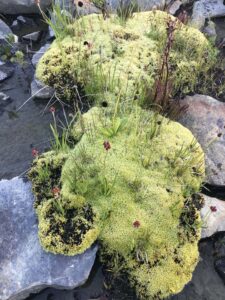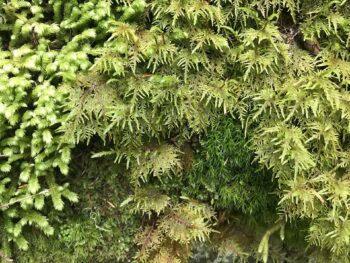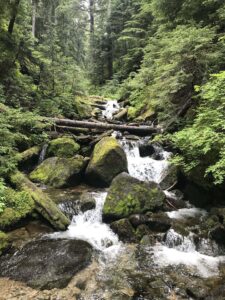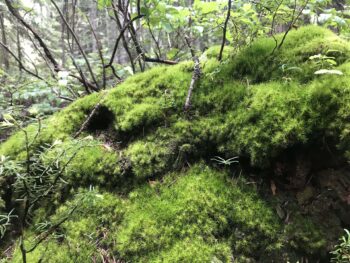 By Emilie Bouvier
By Emilie Bouvier
Last year, while living in the Cascade mountain at Holden Village, I spent a lot of time thinking about mosses. I had a ritual of getting up at daybreak at least a couple of mornings a week (I’m not an actual morning person, let’s be honest) to read in early morning light sitting on the porch swing or curled up in a chair by the window. In this sacred time of the morning quiet, I read Gathering Moss by Robin Wall Kimmerer.
Well known for her book Braiding Sweetgrass, Kimmerer writes at the intersection of indigenous wisdom, plant biology, and personal story. An avid fan of that book, I leaped at the opportunity to hear her speak in Minneapolis, and learned in hearing her of her earlier writings about moss and her background as a bryologist.
“All sorts of mosses flourish from their corners on exposed rocks along stream beds or in the slopes between the towering Douglas Firs and Engelmann Spruce.”
During her talk, she was asked about how we could learn to live more sustainably, and she responded immediately that we have a lot to learn from the mosses. They are, she pointed out, some of the oldest plant life on the planet, so they are clearly very successful at sustainability. Mosses are experts at living small, taking only what they need, and living in balance with others – making them excellent teachers. This stuck with me.
LESS THAN A year later, while in a completely new part of the country, I found myself consistently mesmerized by the mosses around me. Water runs abundantly in the Cascades; all sorts of mosses flourish from their corners on exposed rocks along stream beds or in the slopes between the towering Douglas Firs and Engelmann Spruce. The film camera I was using was mostly quite insufficient for capturing such amazingly tiny beauty. That was ok – mosses required me to put down my work and simply peer down at them at look, … and listen.
 Between hikes I read Robin Wall Kimmerer’s words, learning about the distinctive biological features of mosses, but more, learning from their lives and patterns. I learned about how mosses use their advantage of being small, carving out their space to live in the thin “boundary layer” between a surface and the fast flowing air just inches above it. I learned about how mosses live in relationship to rocks, other plants, air, water, trees.
Between hikes I read Robin Wall Kimmerer’s words, learning about the distinctive biological features of mosses, but more, learning from their lives and patterns. I learned about how mosses use their advantage of being small, carving out their space to live in the thin “boundary layer” between a surface and the fast flowing air just inches above it. I learned about how mosses live in relationship to rocks, other plants, air, water, trees.
“The radical permeability of moss leaves means that, when the wind or sun dry up the moisture, the mosses cannot sustain themselves.
Yet most importantly, I learned about how mosses open themselves up to water. They don’t have the same kind of waxy coat to their leaves that most plants do, in order to hold the water in. Rather than building protective layers and systems of transporting water, mosses have a simple system of permeable leaves. They let in water immediately and directly, even though they then have no way of holding onto that water or transporting it.
This radical permeability means that, when the wind or sun dry up the moisture, the mosses cannot sustain themselves. They curl down and appear to be lifeless. Yet almost miraculously, mosses don’t actually die in this condition. They are not defeated; they are merely dormant. The moment rain falls again the permeable leaves immediately absorb the moisture. Within minutes they open up once again, full of life.

Mosses have a lot to teach us about resiliency. Among all of the lessons mosses have to offer, this is one I most remember and carry. I see their ability to weather the harsh seasons and endure – not by shutting down vulnerability, but opening to it.
Robin Wall Kimmer writes of her own stories and learning in relationship to the mosses. As she navigates her own ups and downs, she herself is moved by the radical vulnerability and fortitude of these small but ordinary life forms. “Mosses have a covenant with change;” she writes, “their destiny is linked to the vagaries of rain. They shrink and shrivel while carefully laying the groundwork of their own renewal. They give me faith.”

Photo credits: Emilie Bouvier
THESE DAYS ARE hard days. There is so much hurting and such deeps wrongs. We have a lot of work to do. But we’ve been talking a lot about the work, so here I am, compelled to add a gentle word about resiliency and the beauty of mosses.
I’ve heard my pastor colleagues often talk about finding themselves preaching the sermon they most need to hear. This is definitely that kind of blog for me.
“Mosses have a covenant with change.”
I need to remember it’s ok to slow down and think small sometimes. I need to remember the mosses teaching me their lessons about the long haul, their openness to raindrops, and the way of reciprocal relationship. I need to give thanks for the tiny beauty of the most ordinary and ubiquitous green life that surrounds us. May their wisdom also be a word of renewal to you this day, that we might be ready for what will be asked of us in the days to come.

